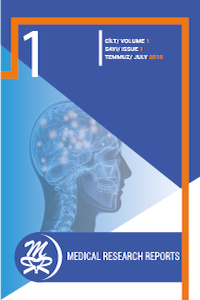Migren hastalarında işgücü kaybının önlenmesinde profilaktik ilaçların etkinliği
Giriş: Migren, ataklarla seyreden ve ataklar arasında semptom göstermeyen tekrarlayıcı bir bozukluktur. Baş ağrısı ve eşlik eden belirtiler, migrenli kişinin yaşamını her zamanki gibi sürdürmesini engeller ve belirgin bir aktivite kısıtlanmasına yol açar. Migren profilaksisinde amaçlar; migren atak sıklığını, süresini ve şiddetini azaltmak, migrenden kaynaklanan kayıpları azaltmak, yaşam kalitesini arttırmaktır.
Bu çalışmada; migren tanısı almış hastalarda profilaktik tedavide kullanılan ilaçların etkinliğini ve iş gücü kaybını en fazla azaltan ilaç grubunu tespit etmeyi amaçladık.
Gereç ve Yöntemler: Baş Ağrısı Polikliniğine başvuran 18-50 yaş arasında, migren tanı kriterlerine uyan ve sistemik herhangi bir hastalığı olmayan, psikiyatrik hastalığı olmayan, en az ilkokul mezunu, düzenli takipli hastalar çalışmaya dahil edildi. Migren tanısı için International Headache Society (IHS) kriterleri, iş gücü kaybı değerlendirmesi için Migren Dizabilite Değerlendirme Ölçeği (MIDAS) kullanıldı.
Bulgular: Çalışmaya alınan 83 hastanın yaş aralığı 18-50, ortalama yaş 34±11,7’dir. Migren yaşları ortalama 7,9±6,8’dir. MIDAS tedavi öncesinde ortalaması 48±22,9, sonrasında 10±12,9’dir. Tedavi öncesi ve sonrası MIDAS karşılaştırıldığında ise migren tipi fark etmeksizin istatistiksel anlamlı farklılık vardır (p
Anahtar Kelimeler:
migren, profilaksi, MIDAS, sertralin, valproat, propranolol, amitriptilin, flunarizin
The effect of prophylactic drugs to prevent loss of work in migraine patients
Introduction: Migraine, is a repetitive disorder which is asymptomatic between attacks. Headache and the accompanying symptoms cause a restriction in daily activities. The aim of prophylaxis is to reduce the occurrence of migraine attacks, decrease it's duration and the severity of headaches.
In this study we aimed to determine the effect of prophylactic drugs.
Material and Methods: In our study we included patients who were diagnosed with migraine and came to follow ups regularly. We chose patients without any accompanying diseases. The diagnosis of migraine was made using International Headache Society (IHS) criteria. In order to evaluate workforce loss we used Migraine Disability Assessment Score (MIDAS).
Results: The age of patients in this study were between 18-50. The median age of 83 patients that were included in the study was 34±11,7. Before prophylaxis MIDAS was 48±22,9 and after prophylactic treatment it was 10±12,9. So we found a statistically significant difference before and after treatment on MIDAS. Most effective prophylaxis was provided with flunarizin.
Conclusion: It is crucially important to provide prophylactic treatment to migraine patients in order to prevent workforce loss and increase the quality of life. The most effective porophylactic agent is found to be flunarizin, a calcium channel blocker.
Keywords:
migraine, prophylaxis, MIDAS, ertraline, valproate, propranolol, amitriptyline, flunarizine,
___
- 1. Stewart, W., A. Shechter, and B. Rasmussen, Migraine prevalence: a review of population-based studies. Neurology, 1994. 44(6).
- 2. Hayran, O., M. Zarifoglu, and A. Siva, Başağrısı epidemiyolojisi. Ağrı, 2000: p. 181-183.
- 3. Graham, J.R. and H.G. Wolff, Mechanism of migraine headache and action of ergotamine tartrate. Archives of Neurology & Psychiatry, 1938. 39(4): p. 737-763.
- 4. Goadsby, P.J., R.B. Lipton, and M.D. Ferrari, Migraine—current understanding and treatment. New England journal of medicine, 2002. 346(4): p. 257-270. 5. Bolay, H., et al., Intrinsic brain activity triggers trigeminal meningeal afferents in a migraine model. Nature medicine, 2002. 8(2): p. 136-142.
- 6. Téllez–Zenteno, J.F., et al., Demographic, clinical and comorbidity data in a large sample of 1147 patients with migraine in Mexico City. The journal of headache and pain, 2005. 6(3): p. 128.
- 7. Hayran, O., M. Zarifoglu, and A. Siva, Basagrisi epidemiyolojisi. Agri. Istanbul: Alemdar Ofset, 2000: p. 181-183. 8. AYGÜL, R., et al., Migrenli hastalarin sosyodemografik profili. MJAU, 2001. 33(1): p. 91-6.
- 9. Schultz, I.Z. and R.J. Gatchel, Handbook of complex occupational disability claims: Early risk identification, intervention, and prevention. 2006: Springer Science & Business Media.
- 10. Edmeads, J., et al., Potential of the Migraine Disability Assessment (MIDAS) Questionnaire as a public health initiative and in clinical practice. Neurology, 2001. 56(suppl 1): p. S29-S34.
- 11. Iadecola, C., From CSD to headache: a long and winding road. Nature Medicine, 2002. 8(2): p. 110-112.
- 12. Lassen, L. and M. Ashina, Nitric oxide synthase inhibition in migraine. The Lancet, 1997. 349(9049): p. 401-402.
- 13. BOYLU, E., T. ADIGZEL, and T. ZDEN, Migrenli Olgularda Dizabilitenin Midas Ölçeği ile Değerlendirilmesi. Duzce Medical Journal, 2012. 14(1).
- 14. YOLDAŞ, T.K., et al., Ardışık 103 migren hastasında MIDAS skorları ve demografik/klinik özellikler. Türk Nöroloji Dergisi, 2008. 14(6): p. 388-393.
- 15. Ray, B.S. and H.G. Wolff, Experimental studies on headache: pain-sensitive structures of the head and their significance in headache. Archives of Surgery, 1940. 41(4): p. 813-856.
- 16. Topcu, Y., et al., The Paediatric migraine disability assessment score is a useful tool for evaluating prophylactic migraine treatment. Acta Paediatrica, 2014. 103(11): p. e484-e489.
- 17. Linde, M., et al., Valproate (valproic acid or sodium valproate or a combination of the two) for the prophylaxis of episodic migraine in adults. Cochrane Database of Systematic Reviews, 2013(6).
- 18. Moras, K. and H. Nischal, Impact of Amitryptiline on Migraine Disability Assessment Score. Journal of clinical and diagnostic research: JCDR, 2014. 8(9): p. KC01.
- 19. Tarlaci, S., Escitalopram and venlafaxine for the prophylaxis of migraine headache without mood disorders. Clinical neuropharmacology, 2009. 32(5): p. 254-258.
- Yayın Aralığı: Yılda 3 Sayı
- Başlangıç: 2017
- Yayıncı: M. Tayyib KADAK
Sayıdaki Diğer Makaleler
COVID-19 Hastalığının Tetiklediği Fulminan Hepatit Vakası
AŞI KARŞITLARININ SOSYAL MEDYA PLATFORMLARINDAKİ PAYLAŞIMLARININ İNCELENMESİ: INSTAGRAM ÖRNEĞİ
Özge TAŞÇI, Mehmet Enes GÖKLER
Migren hastalarında işgücü kaybının önlenmesinde profilaktik ilaçların etkinliği
Ece BALKUV, Elif YILMAZ, Yılmaz ÇETİNKAYA, Recep BAŞARAN, Hülya TİRELİ
DOĞU AFRİKA ÜLKELERİNDE AİLE PLANLAMASI İLE İLGİLİ BİLGİ, TUTUM VE UYGULAMARALI
Sagal Yussuf ADAM, Nimetcan MEHMET
Esansiyel Tremor ve Parkinson Tremorunun Karşılaştırılması
Neci Nur KELEŞ, Ece BALKUV, Recep BAŞARAN, Haşmet Ayhan HANAĞASI
PERİODONTAL VE SİSTEMİK HASTALIKLAR: RESPİRATUAR RAHATSIZLIKLAR
